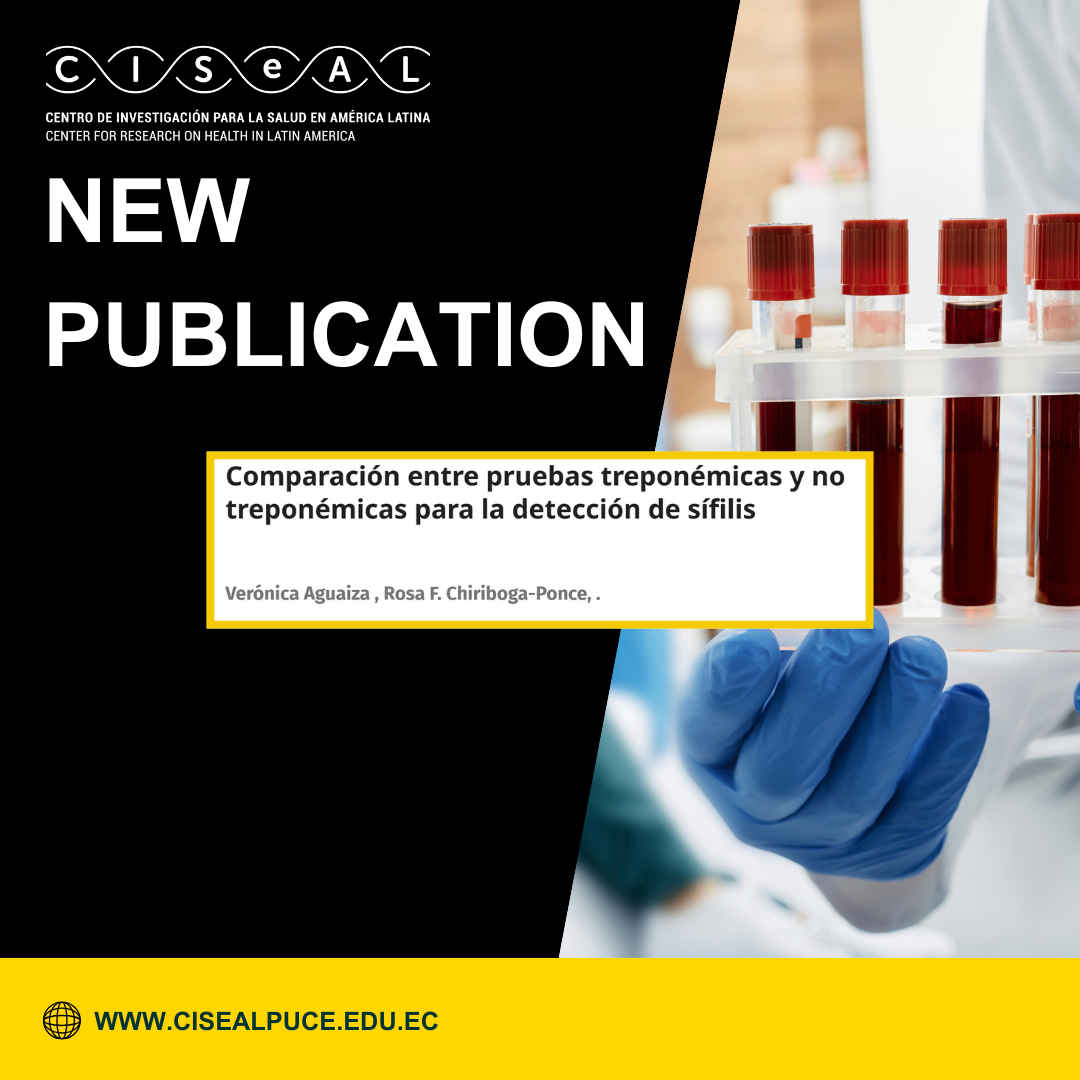 The diagnosis of syphilis continues to rely on two types of serological tests: non-treponemal (NT), used as an initial screening, and treponemal (T), used as confirmatory tests. However, the relationship between both types and their ability to accurately detect the infection remains under analysis, especially in contexts where transfusion safety is critical. With this purpose, Verónica Aguaiza, Bq, and Rosa Chiriboga, MPH, from the Reference Unit for Blood Banks (URBS), evaluated 384 initially reactive samples using VDRL, and subsequently subjected them to VDRL, ELISA, CLIA, and FTA-ABS as the confirmatory reference. The study showed that concordance between NT and T tests was moderate, reaching percentages between 76% and 83%, and that this concordance decreased even further when compared to FTA-ABS, with values ranging from 44.2% to 61.9%. Although all tests demonstrated high sensitivities, significant differences emerged in their predictive value: VDRL presented the highest rate of false positives (up to 94.52%), while the automated treponemal CLIA test achieved the best positive predictive value (95.27%) and the strongest overall performance.
The diagnosis of syphilis continues to rely on two types of serological tests: non-treponemal (NT), used as an initial screening, and treponemal (T), used as confirmatory tests. However, the relationship between both types and their ability to accurately detect the infection remains under analysis, especially in contexts where transfusion safety is critical. With this purpose, Verónica Aguaiza, Bq, and Rosa Chiriboga, MPH, from the Reference Unit for Blood Banks (URBS), evaluated 384 initially reactive samples using VDRL, and subsequently subjected them to VDRL, ELISA, CLIA, and FTA-ABS as the confirmatory reference. The study showed that concordance between NT and T tests was moderate, reaching percentages between 76% and 83%, and that this concordance decreased even further when compared to FTA-ABS, with values ranging from 44.2% to 61.9%. Although all tests demonstrated high sensitivities, significant differences emerged in their predictive value: VDRL presented the highest rate of false positives (up to 94.52%), while the automated treponemal CLIA test achieved the best positive predictive value (95.27%) and the strongest overall performance.
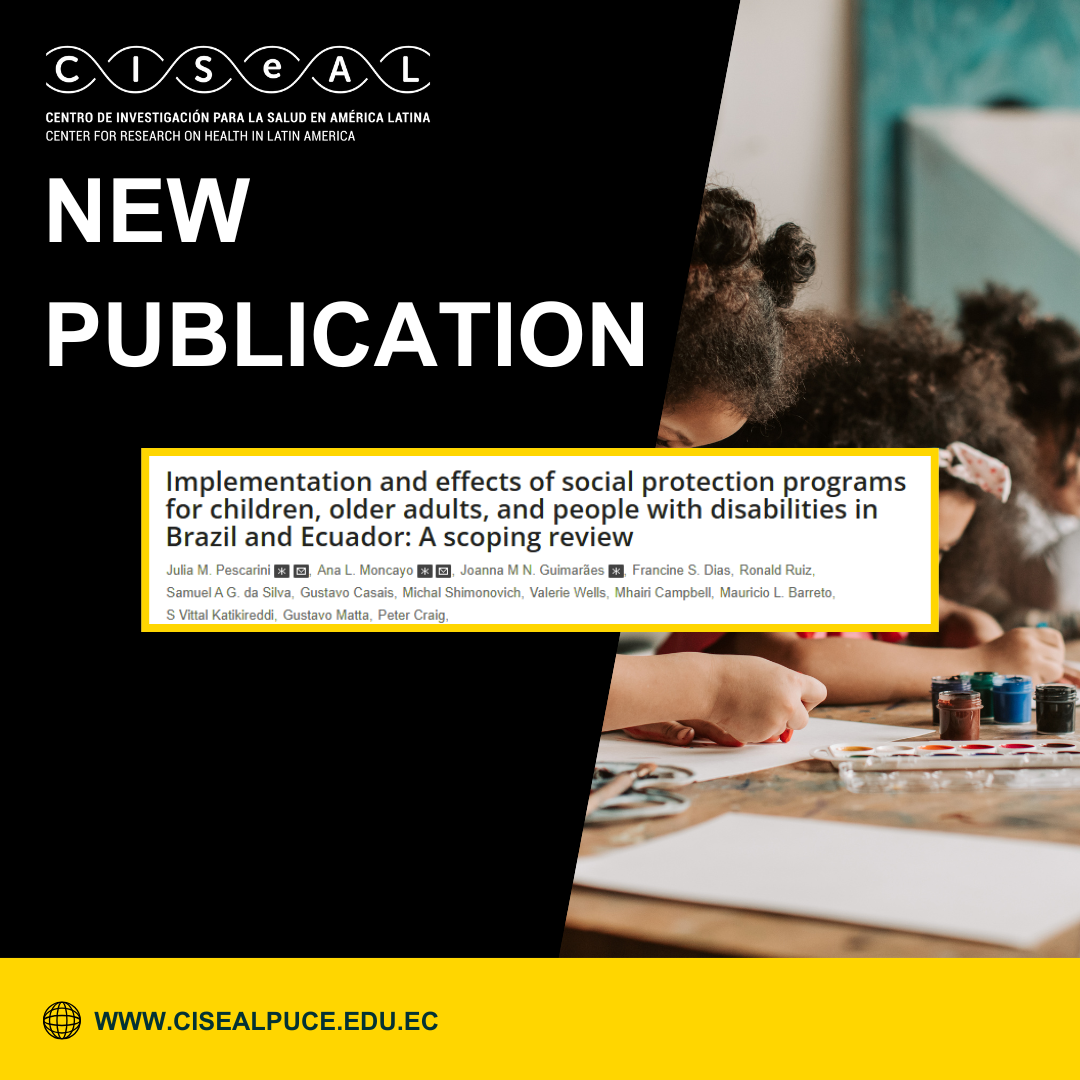 Our Principal Investigator, Dr. Ana Lucía Moncayo, together with Dr. Julia M. Pescarini from the Center for Data and Knowledge Integration for Health (Cidacs) – Brazil, took part in a collaborative study in which they share both first and corresponding authorship. The article, published in PLOS Global Public Health, is titled “Implementation and effects of social protection programs for children, older adults, and people with disabilities in Brazil and Ecuador: A scoping review.”
Our Principal Investigator, Dr. Ana Lucía Moncayo, together with Dr. Julia M. Pescarini from the Center for Data and Knowledge Integration for Health (Cidacs) – Brazil, took part in a collaborative study in which they share both first and corresponding authorship. The article, published in PLOS Global Public Health, is titled “Implementation and effects of social protection programs for children, older adults, and people with disabilities in Brazil and Ecuador: A scoping review.”
This work is part of the SEDHI project (Social and Environmental Determinants of Health Inequalities) and examines how social protection programs targeting children, older adults, and people with disabilities living in poverty have been implemented and what their effects have been in Brazil and Ecuador. The review explores the link between poverty and health in Latin America, where long-standing inequality has driven the creation of policies such as Bolsa Família in Brazil and the Bono de Desarrollo Humano in Ecuador. These programs have helped reduce poverty and improve indicators of education, economic inclusion, and health, although coverage and sustainability gaps persist.
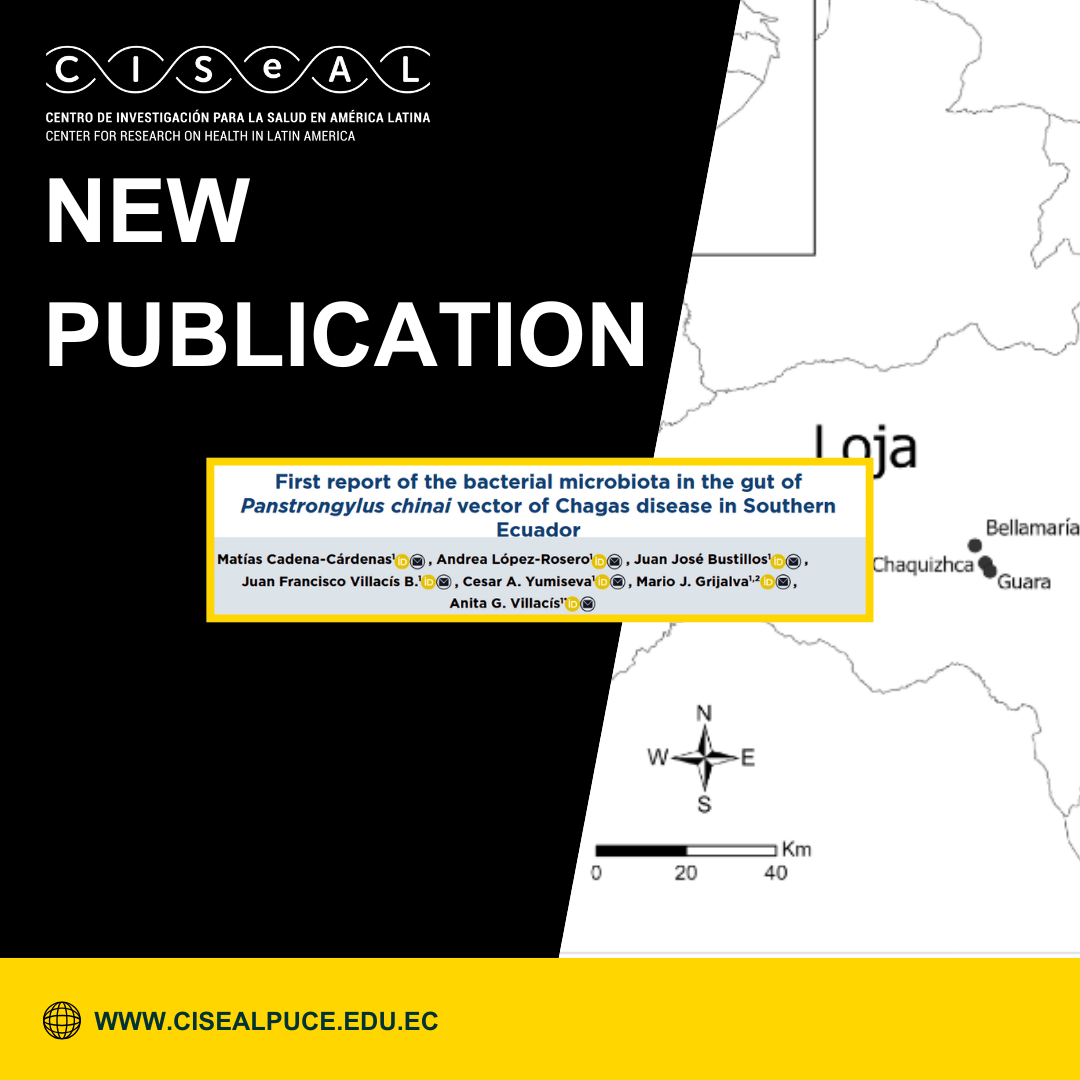 The study represents the first report on the intestinal bacterial microbiota of Panstrongylus chinai, a secondary vector of Chagas disease in southern Ecuador. This research was conducted by the CISeAL team under the direction of Dr. Anita Villacís, with the objective of characterizing the microbial diversity present in the gut of this species and exploring its possible relationship with the transmission of Trypanosoma cruzi.
The study represents the first report on the intestinal bacterial microbiota of Panstrongylus chinai, a secondary vector of Chagas disease in southern Ecuador. This research was conducted by the CISeAL team under the direction of Dr. Anita Villacís, with the objective of characterizing the microbial diversity present in the gut of this species and exploring its possible relationship with the transmission of Trypanosoma cruzi.
Samples were collected from three rural communities in the Calvas canton, Loja province (Guara, Chaquizhca, and Bellamaría), in both domestic and peridomestic environments. The insects were subsequently processed and analyzed using molecular techniques at CISeAL (PUCE) to identify the presence of T. cruzi as well as the composition of the intestinal bacterial community through amplification and sequencing of the 16S rRNA gene.
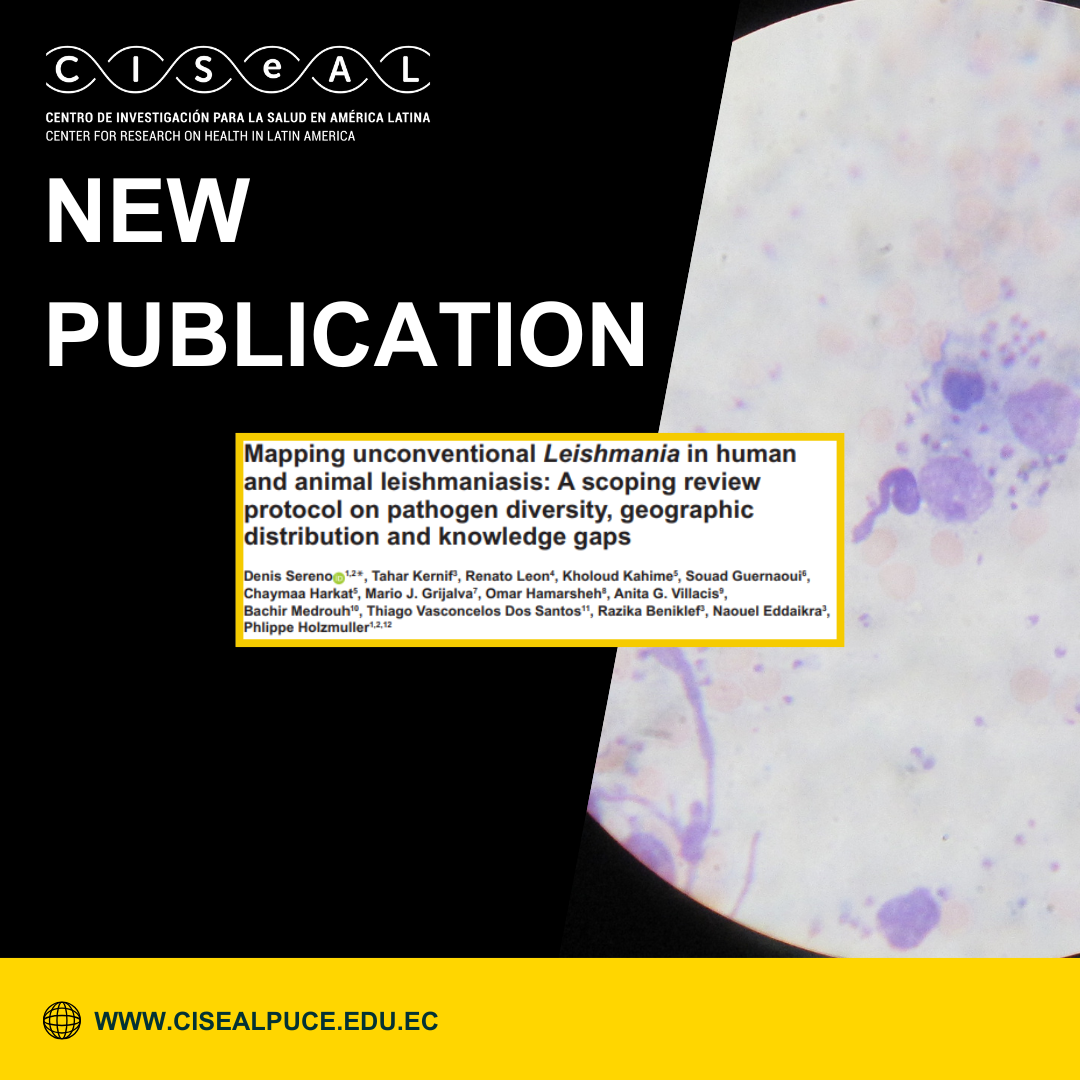 The research led by Dr. Denis Sereno, researcher at the IRD (Institut de Recherche pour le Développement), in collaboration with Dr. Mario Grijalva and Dr. Anita Villacís, principal investigators at CISeAL, addresses an emerging challenge in global public health: the diversity and behavior of non-conventional Leishmania species that cause infections in both humans and animals.
The research led by Dr. Denis Sereno, researcher at the IRD (Institut de Recherche pour le Développement), in collaboration with Dr. Mario Grijalva and Dr. Anita Villacís, principal investigators at CISeAL, addresses an emerging challenge in global public health: the diversity and behavior of non-conventional Leishmania species that cause infections in both humans and animals.
Traditionally, leishmaniases have been attributed to a limited group of species (such as L. donovani, L. infantum, L. major, or L. tropica), each associated with a well-defined clinical presentation. However, advances in molecular diagnostics have revealed a more complex scenario. Recent cases have identified atypical or emerging species, such as those belonging to the subgenus Mundinia (L. martiniquensis, L. orientalis), as well as unusual clinical manifestations in classical species—challenging traditional models of diagnosis and surveillance.
 After the COVID-19 pandemic, the city of Quito faced the enormous challenge of transforming its primary health care system, which had been weakened by the health emergency and hospital overload. The following study analyzes how the city reconfigured its model of Community Primary Health Care (CPHC) during and after the pandemic, becoming a regional reference in health resilience and local governance. Entitled “Strengthening primary health care resilience through community innovation: a qualitative case study from Quito’s response to COVID-19”, it was led by Dr. Betzabé Tello, principal researcher at CISeAL-PUCE, and received support from the World Bank as part of its technical assistance agenda to strengthen resilient primary health care systems in Latin America.
After the COVID-19 pandemic, the city of Quito faced the enormous challenge of transforming its primary health care system, which had been weakened by the health emergency and hospital overload. The following study analyzes how the city reconfigured its model of Community Primary Health Care (CPHC) during and after the pandemic, becoming a regional reference in health resilience and local governance. Entitled “Strengthening primary health care resilience through community innovation: a qualitative case study from Quito’s response to COVID-19”, it was led by Dr. Betzabé Tello, principal researcher at CISeAL-PUCE, and received support from the World Bank as part of its technical assistance agenda to strengthen resilient primary health care systems in Latin America.
The study aimed to document how Quito transitioned from a reactive, hospital-centered model to a community-based, preventive, and territorial one, grounded in the social determinants of health and citizen participation. To achieve this, a qualitative approach was applied, including a documentary review of institutional sources, municipal reports, legal frameworks, and accountability documents from 2014 to 2024, complemented by in-depth interviews with health professionals, decision-makers, and administrative staff. This approach allowed for an understanding of both the institutional structure and the implementation processes of the model throughout the Metropolitan District.

CISeAL researchers Carolina Portero, M.Sc., in collaboration with Dr. María Raquel Marchán-Rivadeneira, have developed a study that proposes an innovative strategy to combat SARS-CoV-2 infections through the development of synthetic probiotic bacteria capable of producing and releasing neutralizing nanoantibodies directly at the site of infection. The work is based on the premise that, although vaccines have been fundamental in controlling the pandemic, there is still a need for antiviral therapies that block early stages of the viral cycle, such as the binding of the RBD domain of the spike protein to the human ACE2 receptor, a key process for the virus to enter cells. In this context, nanoantibodies, derived from camelid antibodies, offer advantages over monoclonal antibodies due to their small size, stability, and ease of genetic manipulation, but they face limitations associated with their rapid degradation and the need for repeated administration. To overcome these challenges, a recombinant strain of Lactococcus lactis, a safe and widely used probiotic, was designed to act as a biological vehicle for producing and carrying nanoantibodies. Through genetic engineering, vectors capable of expressing the H11-D4 and H11-H4 nanoantibodies anchored to the bacterial surface were constructed, optimizing the secretion and fixation system to ensure their stability and external exposure.
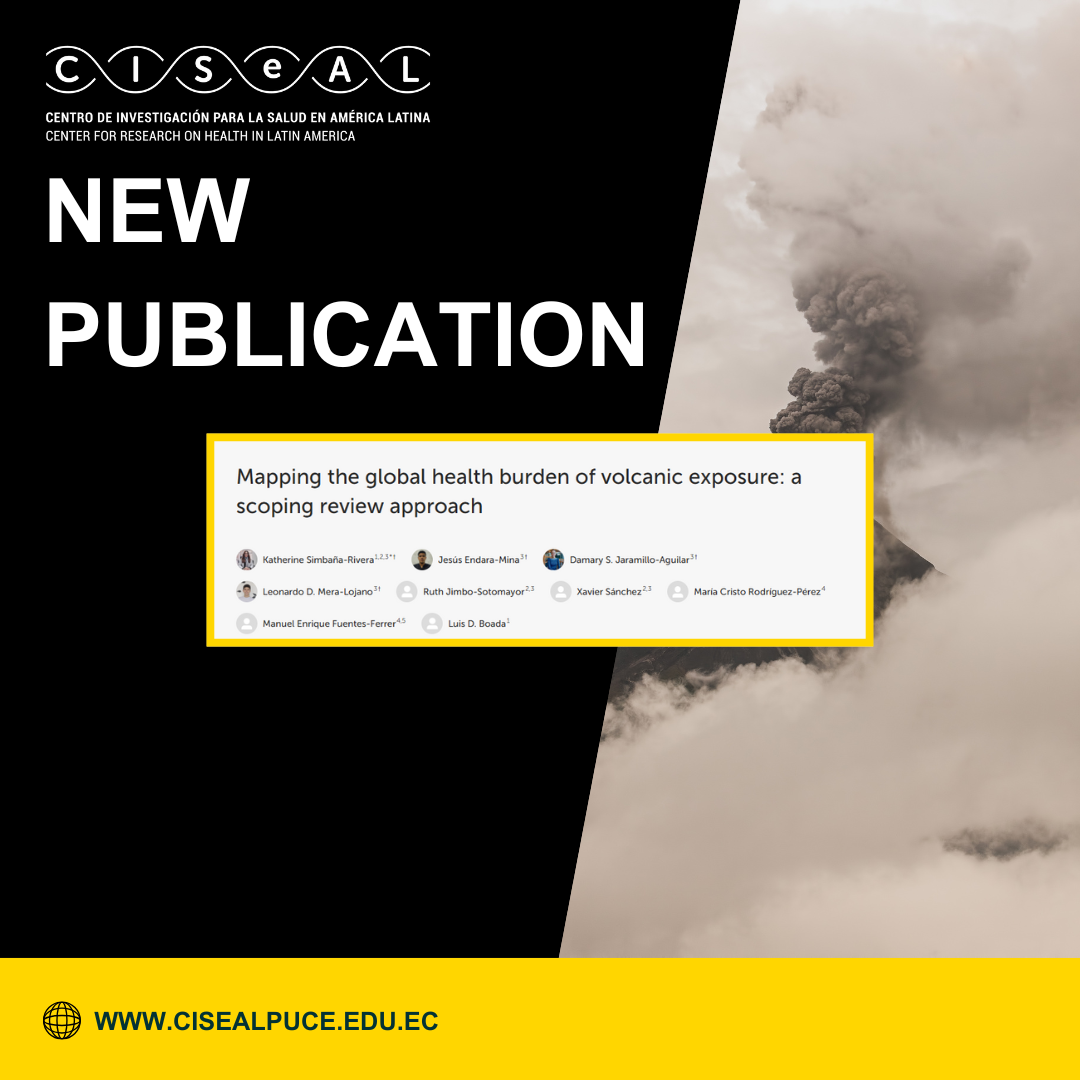 The study conducted by Dr. Katherine Simbaña, Dr. Xavier Sánchez, and Dr. Ruth Jimbo Sotomayor, professors at the School of Medicine of PUCE and researchers at CISeAL, together with other experts, provides a global overview of the health effects of exposure to volcanic activity through a scoping review approach. The research is framed within a context where there are approximately 1,500 potentially active volcanoes worldwide, more than 550 of which have erupted in the past century, with a marked concentration in the Pacific Ring of Fire that runs through densely populated areas of Asia and the Americas. Volcanoes such as Fuego in Guatemala, Popocatépetl in Mexico, Tungurahua in Ecuador, and Merapi in Indonesia have produced highly explosive eruptions with major social and health consequences. The so-called “volcanic products,” which include ash, gases, pyroclastic flows, lava, and chronic emissions of pollutants such as carbon dioxide or radon, have differentiated health impacts depending on their physical and chemical properties, as well as on the duration and magnitude of exposure. In addition, external factors such as climate change, which intensifies secondary phenomena such as lahars or ash resuspension, and social determinants such as poverty, unplanned urbanization, and limited land-use planning significantly increase the vulnerability of populations living in high-risk areas.
The study conducted by Dr. Katherine Simbaña, Dr. Xavier Sánchez, and Dr. Ruth Jimbo Sotomayor, professors at the School of Medicine of PUCE and researchers at CISeAL, together with other experts, provides a global overview of the health effects of exposure to volcanic activity through a scoping review approach. The research is framed within a context where there are approximately 1,500 potentially active volcanoes worldwide, more than 550 of which have erupted in the past century, with a marked concentration in the Pacific Ring of Fire that runs through densely populated areas of Asia and the Americas. Volcanoes such as Fuego in Guatemala, Popocatépetl in Mexico, Tungurahua in Ecuador, and Merapi in Indonesia have produced highly explosive eruptions with major social and health consequences. The so-called “volcanic products,” which include ash, gases, pyroclastic flows, lava, and chronic emissions of pollutants such as carbon dioxide or radon, have differentiated health impacts depending on their physical and chemical properties, as well as on the duration and magnitude of exposure. In addition, external factors such as climate change, which intensifies secondary phenomena such as lahars or ash resuspension, and social determinants such as poverty, unplanned urbanization, and limited land-use planning significantly increase the vulnerability of populations living in high-risk areas.
The study, conducted using the scoping review methodology and following international guidelines such as PRISMA-ScR, included 83 articles after a rigorous selection process that began with 2,077 records identified in databases such as PubMed, Scopus, and Web of Science. The countries with the largest number of publications were the United States, Japan, and Iceland, and among the most studied volcanoes are Mount St. Helens, Kīlauea, Eyjafjallajökull, and Miyakejima. Most of the analyzed studies focused on adult populations, while research on children was less frequent. The most studied pollutants were toxic gases and volcanic ash, both responsible for a wide range of health effects.



